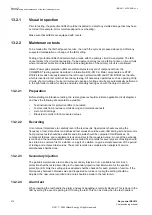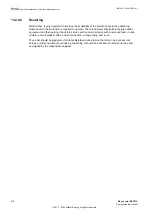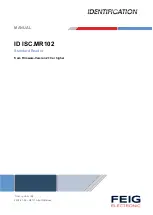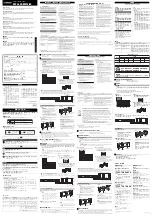
inserted or the IED is set to test mode from the local HMI. At the end of the secondary injection test it
should be checked that the event and alarm signalling is correct by activating the events and
performing some selected tests.
13.2.2.5
Self supervision check
SEMOD56528-23 v6
Once secondary testing has been completed, it should be checked that no self-supervision signals
are activated continuously or sporadically. Especially check the time synchronization system, GPS or
other, and communication signals, both station communication and remote communication.
13.2.2.6
Trip circuit check
SEMOD56528-26 v5
When the protection IED undergoes an operational check, a tripping pulse is normally obtained on
one or more of the output contacts and preferably on the test switch. The healthy circuit is of utmost
importance for the protection operation. If the circuit is not provided with a continuous trip-circuit
supervision, it is possible to check that circuit is really closed when the test-plug handle has been
removed by using a high-ohmic voltmeter and measuring between the plus and the trip output on the
panel. The measurement is then done through the trip coil of the circuit breaker and therefore the
complete trip circuit is checked.
Note that the breaker must be closed.
Please observe that the test system does not provide built-in security during this test.
If the instrument should be set on Amp instead of Volts, the circuit breaker naturally
is tripped, therefore, great care is necessary.
Trip circuit from trip IEDs to circuit breaker is often supervised by trip-circuit supervision. It can then
be checked that a circuit is healthy by opening tripping output terminals in the cubicle. When the
terminal is opened, an alarm shall be achieved on the signal system after a delay of some seconds.
Remember to close the circuit directly after the test and tighten the terminal carefully.
13.2.2.7
Measurement of service currents
SEMOD56528-30 v4
After a maintenance test it is recommended to measure the service currents and service voltages
recorded by the protection IED. The service values are checked on the local HMI or in PCM600.
Ensure that the correct values and angles between voltages and currents are recorded. Also check
the direction of directional functions such as Distance and directional overcurrent functions.
For transformer differential protection, the achieved differential current value is dependent on the tap
changer position and can vary between less than 1% up to perhaps 10% of rated current. For line
differential functions, the capacitive charging currents can normally be recorded as a differential
current.
The zero-sequence current to earth-fault protection IEDs should be measured. The current amounts
normally very small but normally it is possible to see if the current circuit is "alive".
The neutral-point voltage to an earth-fault protection IED is checked. The voltage is normally 0.1 to
1V secondary. However, voltage can be considerably higher due to harmonics. Normally a CVT
secondary can have around 2.5 - 3% third-harmonic voltage.
1MRK 511 403-UEN Rev. L
Section 13
Commissioning and maintenance of the fault clearing system
Bay control REC670
215
Commissioning manual
© 2017 - 2022 Hitachi Energy. All rights reserved
Содержание REC670
Страница 1: ...Relion 670 SERIES Bay control REC670 Version 2 2 IEC Commissioning manual ...
Страница 2: ......
Страница 28: ...22 ...
Страница 54: ...48 ...
Страница 60: ...54 ...
Страница 66: ...60 ...
Страница 90: ...84 ...
Страница 212: ...206 ...
Страница 218: ...212 ...
Страница 232: ...226 ...
Страница 240: ...234 ...
Страница 241: ...235 ...
















































